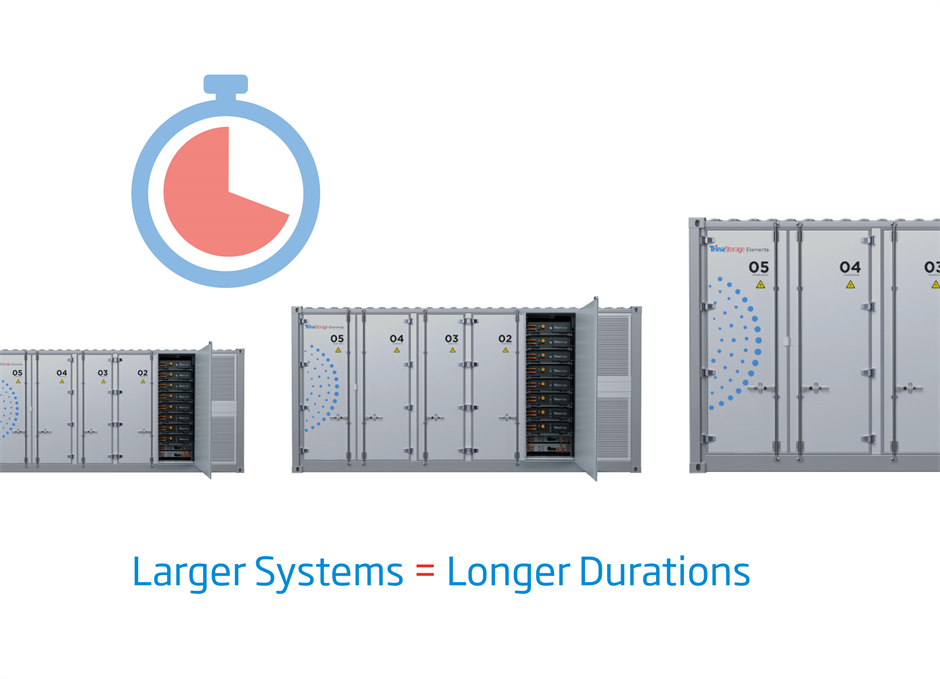How Large Battery Energy Storage Systems are Reshaping the Market
- 24/04/12
- Energy Storage
As we reported in our last Insights article, the 2024 Energy Storage Outlook is shaping up to see a surge in large-scale energy storage system deployments throughout the year. This marks a pivotal moment in the renewable energy transition, enhancing the resilience of energy grids worldwide.
In this article, we’ll be showcasing the evolution towards bigger energy storage systems, the technological advancements that are driving this change, and how Elementa 2 is leading the charge with its class-leading innovations.
The evolution of larger BESS deployments
The energy storage sector is currently undergoing a significant transformation. The familiar smaller-scale BESS units are gradually being replaced by much larger systems, with capacities reaching up to 5MWh in a single container.
This shift is driven by a combination of market trends and technological advancements that are steering us towards these larger, more energy dense and efficient storage systems.
Whilst there are varying market forecasts, McKinsey have recently estimated that BESS capacity is likely to quintuple between now and 2030, with utility-scale storage accounting for over 80% of the ratio at its peak.

What's driving the market shift?
Increased renewable energy consumption
As Governments around the world continue to invest in renewable energy power through policy and subsidies, energy grids require higher capacities of renewable sources like solar and wind power, the need for more substantial and more reliable energy storage solutions becomes paramount.
Increasing economies of scale
The move towards larger energy storage systems brings significant cost advantages. As the size of the storage system increases, the cost per unit of stored energy tends to decrease. This means customers can expect more storage capacity for their investment, making large-scale energy storage projects more financially viable and attractive.
Larger systems can be optimised for longer durations
Larger BESS systems can provide sustained power for longer durations, offering an essential safety net for regions prone to power outages or businesses that require uninterrupted power for their operations. This increased reliability is a critical factor in decision-making regarding energy storage solutions.
Energy storage innovations enabling change
Recent progress in BESS innovation has enabled the manufacturing of larger, more efficient storage systems, and crucially, without increasing their physical footprint. Design innovations are keeping pace, optimising these larger systems for better performance and safety.

Higher energy densities
Advances in battery chemistry and design have led to higher energy densities, allowing more energy to be stored in a smaller space, making large-scale storage systems more practical and efficient for a number of market applications, including:
-
Grid stability and resilience
Higher energy densities play a crucial role in maintaining grid stability and resilience by providing frequency regulation, voltage support, and backup power during grid outages or peak demand periods, improving overall system efficiency and reliability. -
Peak shaving and demand response
Utilities and commercial facilities can reduce electricity costs by storing higher density energy during off-peak hours and discharging during peak demand periods, thereby avoiding expensive peak electricity prices and optimising energy consumption.
Improved energy management systems
Enhanced EMS technologies provide better control and optimization of battery performance, safety, and lifespan, making larger systems more reliable and easier to manage.
Modular and scalable designs
The development of modular BESS designs enables customers to scale their energy storage capacity as needed, making it easier to start with a large base and expand in response to growing energy requirements
Advanced cooling systems
With increasing energy density, thermal management becomes a critical factor responsible for lifetime, performance, and safety aspect of BESS. Innovations in cooling technologies ensure that larger BESS units maintain optimal operating temperatures, improving efficiency and prolonging system life even at higher capacities.

Better battery durability
Technological improvements have also led to batteries that can withstand more charge and discharge cycles, making larger systems more viable for long-term use.
Smart grid compatibility
Larger BESS units are increasingly designed to be compatible with smart grid technologies, allowing for more efficient energy management and distribution, catering to the needs of modern electrical grids.
Trina's new Elementa 2 BESS leads the charge
Using Trina's vertically integrated LFP cells, Elementa 2 is Trina's new generation of cutting-edge, grid-scale storage systems that have been designed and built from the ground up. Here's why Elementa 2 is leading the charge.

Easy transition to large scale energy storage
Elementa 2 has been engineered to ease the transition towards large-scale energy storage adoption. Its intuitive design and compatibility with various operational scales simplify the expansion of storage capabilities, ensuring a seamless integration process for businesses scaling up their energy storage solutions.
Leading performance and safety control
The larger configurations of Elementa 2 systems with the advancements in technology pass on significant performance improvements that ultimately enhance the lifetime of our battery energy storage systems. Crucially, it's the next level safety control that adheres to strict regulatory standards for longevity and peace of mind.
Extending operational duration
Elementa 2 is built with advanced cyclic capabilities and containerised battery technologies, which enhance their operational longevity and efficiency. These innovations ensure that the systems not only last longer but also maintain optimal performance levels over time, delivering sustained value and reliability in energy storage.
For more information on how Elementa 2 can supercharge your transition to energy storage success, visit this page and download the technical specifications.
Read more <the business case for energy storage>
Relevant Topics
Smart Energy Solutions
delivered straight to your inbox

